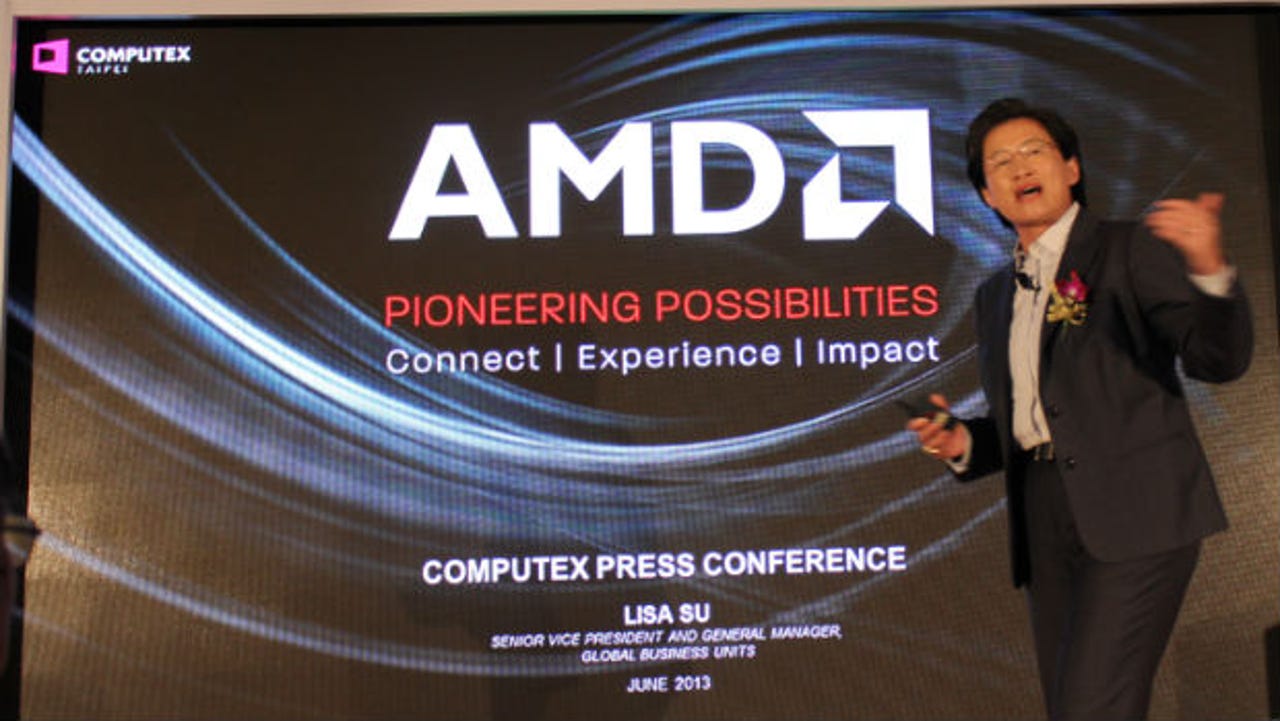Computex 2013: AMD announces more Richland chips, demonstrates Kaveri processor


AMD announced desktop versions of its latest Richland A-Series processors and gave the first public demonstration of its upcoming Kaveri processor at the Computex tradeshow today.
The company is currently shipping its third-generation APUs (Accelerated Processing Units) including Temash, Kabini and Richland. AMD said these APUs, which combine x86 CPUs with high-performance are key to AMD’s strategy.
“AMD invented the APU. The APU is really the future of computing,” said Dr. Lisa Su, Senior Vice President and General Manager, noting that more than 40 percent of the chip’s die area is devoted to graphics. “Our competitor is following and the truth is they will continue to follow.” Yesterday competitor Intel launched its fourth-generation Core processors, which feature improved graphics performance.
The next step, she said, is to expand AMD’s portfolio of IP and solutions to emerging product categories such as ultrathins and new client form factors; low-power, dense micro-servers; and embedded and semi-custom solutions such as the Sony PlayStation 4 and Microsoft Xbox One.
The PC market is changing, and while traditional notebooks are still important, the growth is coming from “new converged form factors” bridging the gap between media tablets for consumption and traditional notebooks, which are more powerful. These new form factors--tablets, hybrids and small touch notebooks--is where AMD is focused. “This is where we see the growth over the next few years,” Su said. It also happens to be the same “2-in-1” segment that Intel is targeting with Haswell and Bay Trail.
Temash, which is focused on tablets and convertibles, includes quad-cores that uses less than 10 watts and dual-cores that uses less than 5 watts. The Acer Aspire V5 Series is the first to use Temash A4 and A6 APUs, but Su said other OEMs will launch systems in coming weeks. She also showed an MSI 11.6-inch Windows 8 tablet with Temash that is less than 10mm thick. Kabini, which AMD bills as the first quad-core x86 SoC for entry-level and mainstream systems, will be available in systems at prices below $500 and with as much as 10 hours of battery life, Su said.
At the top of AMD’s APU lineup, Richland is designed for high-performance graphics and compute, but can still deliver up to 10 hours of battery life, Su said. The desktop versions with Radeon HD 8000 graphics, which AMD launched today, are capable of 779 gigaflops of peak performance. They also use the same FM2 socket and motherboards as the current Trinity APUs, which makes upgrades easier. Su showed benchmark results for PCMark 8 and 3DMark Fire Strike that indicated Richland A10 desktop APUs are on par with Haswell Core i5 4670K and 4430 processors on productivity applications and faster on 3D graphics. We’ll obviously need to see independent tests of Richland desktop APUs to see how it really stacks up to Haswell (also these Core i5s use Intel’s HD 4600 graphics, not the faster Iris graphics in some Haswell processors).
AMD gave the first public demonstration of AMD's fourth-generation Kaveri APU, which will be the company’s first chip to support its heterogeneous, unified memory architecture. This feature is designed to make it easier for developers to create applications that can take advantage of both the CPU and GPU. AMD id not demonstrate any GPU compute applications, however, though they did show the APUs 3D graphics capabilities on Ninja Theory’s DMC: Devil May Cry. Su said that AMD has been sending sample Kaveri APUs to customers for the past few months and will begin shipping it towards the end of the year.
AMD said that gaming is a $100 billion a year business including $40 billion for PC gaming hardware and software, $40 billion for console gaming and another $20 billion for mobile gaming on tablets and smartphones. “So when we look at our strategy going forward, we say how can we get a piece of that market,” said Matt Skynner, Corporate Vice President and general manager of the graphics business. He talked about AMD’s gaming strategy on the client, in the cloud and with content developers.
Skynner said that games are developed for consoles and then ported to the PC. Since AMD chips are in the next-generation consoles, new games are likely to work best on AMD-based PCs, he argued, adding that the company already has the fastest desktop (Radeon HD 7990) and mobile (Radeon HD 8970M) GPUs. (Nvidia would, of course, disagree with this.) He showed the MSI GX70 desktop replacement with the Radeon 8970M, which he said lets you play demanding games at the highest quality settings, along with several smaller laptops with mid-range Radeon 8000 graphics including the Acer Aspire V5, Asus U38DT, and Lenovo Y Series.
Earlier this year AMD announced its Radeon Sky dual-GPU graphics cards with passive cooling for cloud gaming servers. AMD gave a demonstration of an HP Pavilion DM1 11.6-inch laptop with an A6 APU playing IO Interactive’s Hitman: Absolution using the Ubitus cloud gaming service based on Opteron servers with Radeon Sky 700 graphics cards.
Finally Skynner talked about AMD’s work with game developers to make content look better on AMD graphics and the Never Settle and Never Settle Reloaded game bundles. Jurjen Katsman, the CEO of Nixxes, talked about how AMD worked with his company on Deus Ex: Human Revolution, Hitman: Absolution and Tomb Raider. For example, Nixxes, Crystal Dynamics and AMD jointly developed the TressFX technology in Tomb Raider, which simulates the movement of Lara Croft’s individual strands of hair. Katsman announced that Nixxes will release a new AMD Gaming Evolved title, called Thief, in 2014. AMD wrapped up the press conference with an updated version of its well-known Ruby demo, using an actual game engine (CryTek’s CryEngine 3) and running on the Radeon HD 7990, which illustrated how far gaming hardware has come in the past decade.